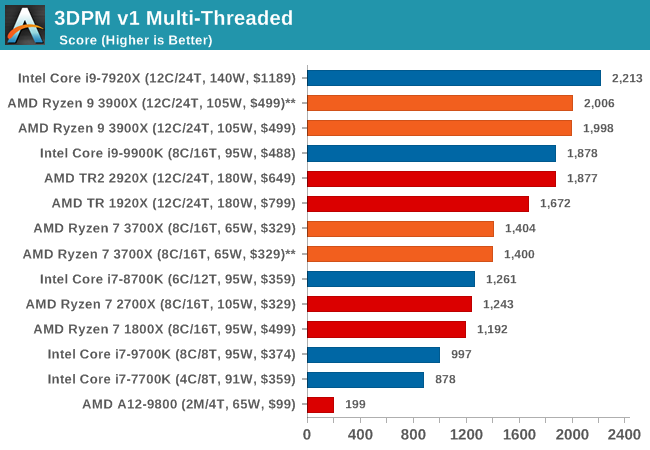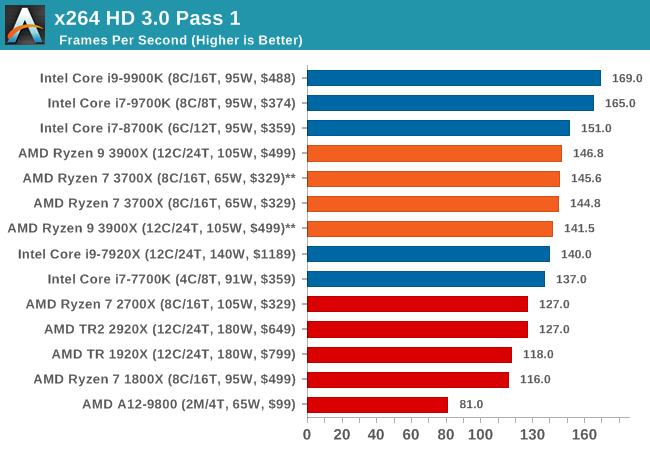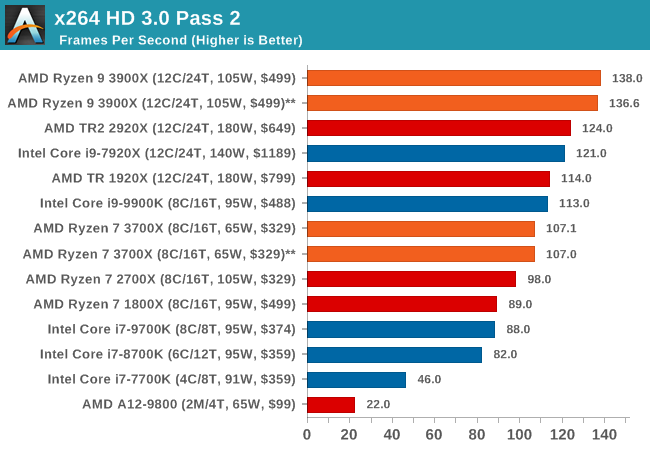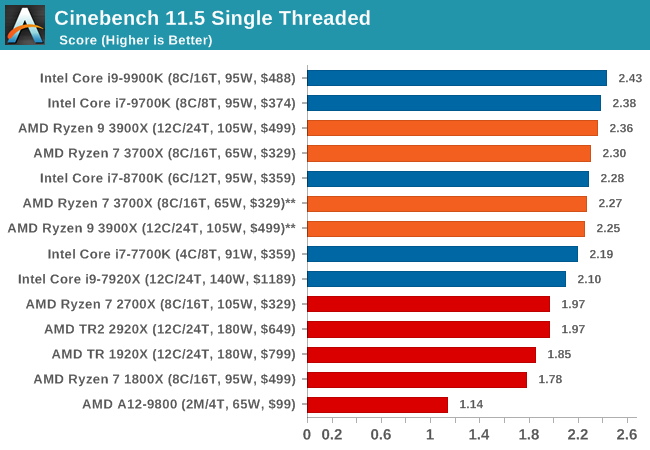The AMD 3rd Gen Ryzen Deep Dive Review: 3700X and 3900X Raising The Bar
by Andrei Frumusanu & Gavin Bonshor on July 7, 2019 9:00 AM EST** = Old results marked were performed with the original BIOS & boost behaviour as published on 7/7.
Benchmarking Performance: CPU Legacy Tests
3DPM v1: Naïve Code Variant of 3DPM v2.1
The first legacy test in the suite is the first version of our 3DPM benchmark. This is the ultimate naïve version of the code, as if it was written by scientist with no knowledge of how computer hardware, compilers, or optimization works (which in fact, it was at the start). This represents a large body of scientific simulation out in the wild, where getting the answer is more important than it being fast (getting a result in 4 days is acceptable if it’s correct, rather than sending someone away for a year to learn to code and getting the result in 5 minutes).
In this version, the only real optimization was in the compiler flags (-O2, -fp:fast), compiling it in release mode, and enabling OpenMP in the main compute loops. The loops were not configured for function size, and one of the key slowdowns is false sharing in the cache. It also has long dependency chains based on the random number generation, which leads to relatively poor performance on specific compute microarchitectures.
3DPM v1 can be downloaded with our 3DPM v2 code here: 3DPMv2.1.rar (13.0 MB)


x264 HD 3.0: Older Transcode Test
This transcoding test is super old, and was used by Anand back in the day of Pentium 4 and Athlon II processors. Here a standardized 720p video is transcoded with a two-pass conversion, with the benchmark showing the frames-per-second of each pass. This benchmark is single-threaded, and between some micro-architectures we seem to actually hit an instructions-per-clock wall.


CineBench 11.5 and 10
Cinebench is a widely known benchmarking tool for measuring performance relative to MAXON's animation software Cinema 4D. Cinebench has been optimized over a decade and focuses on purely CPU horsepower, meaning if there is a discrepancy in pure throughput characteristics, Cinebench is likely to show that discrepancy. Arguably other software doesn't make use of all the tools available, so the real world relevance might purely be academic, but given our large database of data for Cinebench it seems difficult to ignore a small five minute test. We run the modern version 15 in this test, as well as the older 11.5 due to our back data.












447 Comments
View All Comments
shakazulu667 - Sunday, July 7, 2019 - link
Is there a compilation test coming for chromium or another big source tree, that would show if new IO arch brings wider benefits for such CPU+IO workloads?Andrei Frumusanu - Sunday, July 7, 2019 - link
We'll be re-adding the Chromium compile test in the next few days - there were a few technical hiccups when running it.shakazulu667 - Sunday, July 7, 2019 - link
Thanks, I'm looking forward to it, especially curious if AMD can utilize NVMe better for this kind of workload.Andrei Frumusanu - Sunday, July 7, 2019 - link
Unfortunately we don't test the CPU suite with different SSDs for this.shakazulu667 - Sunday, July 7, 2019 - link
Is there another test in your suite that could show improvements with IO , incl NVMe?RSAUser - Monday, July 8, 2019 - link
But one of the big features is PCIe 4 support, so testing with an nvme drive as well to show difference would be important? People spending $490 on a CPU only are probably going to be buying an Nvme SSD.A5 - Monday, July 8, 2019 - link
There aren't any PCIe 4 SSDs for them to test with.0ldman79 - Monday, July 8, 2019 - link
Yep, PCIe 4.0 NVME is going to be beta at this point at best.Last I read the first 4.0 NVME to be released is essentially running an overclocked 3.0 interface, which the list of NVME that can saturate 3.0 is pretty short as it is.
RSAUser - Tuesday, July 9, 2019 - link
That's because these are the first PCIe 4 slots that exist, can't release a product that can't even be used.Using an overlocked drive in lieu of a 4 one is the proper thing to do.
Kevin G - Tuesday, July 9, 2019 - link
For consumers yes but the first PCIe 4.0 host system was the IBM POWER9 released ~18 months ago. As such there are a handful of NIC and accelerators for servers out there today.The real oddity is that nVidia doesn’t support PCIe 4.0. Volta’s nvLink has a PHY based upon PCIe 4.0. Turing should as well though nVidia doesn’t par those chips with the previously mentioned POWER9.